Translate this page into:
One APOS, one voice!
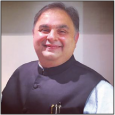
Address for correspondence: Prof. Nikhilesh R. Vaid, Ground Floor, New Blue Gardenia Hsg Society, Peddar Road, Mumbai 26, India. E-mail: orthonik@gmail.com
This article was originally published by Wolters Kluwer and was migrated to Scientific Scholar after the change of Publisher.
The flight back from the International Orthodontic Congress in London this September, was a memorable one. Reminiscing moments of fraternal interactions, scientifi c learnings, immaculate organization and watching the orthodontic world literally converge on a single platform to “smile” was quite an experience!
The weather was the best September could offer: summer’s best of weather, and autumn’s best of cheer! It was as if the world of Orthodontics had carried its own sunshine to London to celebrate the greatest festival of Orthodontics!
For the Asian Pacifi c Orthodontic Society, the event had two major highlights: The APOS Scientifi c World Village Day (WVD) and the APOS cocktail reception both hosted on the 29th of September at ExCel, London. The theme for the day was “one APOS, one voice!”
Why this theme? To get started, it’s imperative we discuss the Asian Pacifi c Region fi rst.
THE ASIA-PACIFIC
The Asia-Pacifi c region is of vast proportions, stretching northward to Mongolia, southward to New Zealand, eastward to the island states of Oceania, and westward to Pakistan. It also encompasses an enormous variation of climate and topography, from tropical to arctic, and from the Himalayas to coral reefs.
In addition to its immense physical expanse, the region also presents a great historical, cultural, and ethnic diversity as well as a variety of stages of political evolution and economic development. The characteristics of the region are most diverse in terms of natural, environmental, economic, and cultural.
The region can be subdivided biogeographically into the continental, archipelagic, and small island ecosystems. In totality, related to the biogeographic characteristics, the region has a dominant marine environment. There are at least three tectonic belts and unique and diversifi ed natural environment. The marine life spreads out from the Pacifi c Basin, to the South China Sea, Indian Ocean down to the Antarctic in the south. The climatic patterns therefore range from the tropical to temperate climate zones. Topographically, the Asia-Pacifi c region is characteristically represented by the highest mountain peaks of the Himalayas (“the roof of the world”) and the deepest ocean floor in the Sulu Sea. Due to the great diversity of Asia-Pacifi c terrestrial and marine ecosystems, the whole area contains probably the greatest biological diversity on earth.
HUMAN CHARACTERISTICS OF THE ASIA-PACIFIC
There is not one single society, political system, economic system, culture, or religion that defi nes the Asia-Pacifi c region and this aspect also differentiates it from other regions of the world. The populations of each country located within the Asia-Pacifi c region have each been moulded very differently by their individual histories and geographies.
The region is home to many racial, cultural, ethnic, linguistic, and religious groups which have over time converged and diverged from one another. Factors such as colonization, war, political instability, economic instability, the availability and use of natural resources, and natural disasters have had an impact in very differential patterns on the countries which form the region.
There is no single Asian language. Most regions speak different languages and dialects. Sometimes even within a region, linguistics can be a barrier.
When we talk of the quality of life, the Human Development Index (HDI) for this region is also diverse. The HDI is a comparative measure of life expectancy, literacy, education, standards of living, and quality of life for countries worldwide. It is a standard means of measuring well-being, especially child welfare. It is used to distinguish whether the country is a developed, a developing, or an underdeveloped country, and also to measure the impact of economic policies on quality of life. The index was developed in 1990 by Indian economist Amartya Sen and Pakistani economist Mahbub ul Haq. The HDI is included in a United Nations Development Programme’s Human Development Report. The latest report was released on July 24, 2014 and compiled on the basis of estimates for 2013.[1]
When we peruse the 2014 HDI ratings,[2] Australia from the Asia-Pacific is No. 2 in Global rankings and New Zealand no. 7, Hong Kong and South Korea are ranked no. 15, Japan no. 17 (Very High Human Development): Malaysia is ranked no. 62, Sri Lanka 73, Thailand 89, and China 91 also having High Human Development. The Asian Pacific Countries in the Medium Human Development category are Indonesia ranked 108, Philippines 117, India 135, and Bangladesh 142. The Low HDI countries in the region include Nepal (rank 145), Pakistan (rank 146).
This diversity in Human Development also affects the needs, delivery, and modalities of health care and health care education. For Orthodontists from such diverse backgrounds to converge on a single forum for fraternal bonding and scientific deliberations, and speak in “one voice” is indeed noteworthy.
THE APOS WORLD VILLAGE DAY
The one voice that the Asian Pacific Orthodontic Society speaks in, despite the diverse cultural and geographical origins of its constituents, is the language of “Orthodontics!” If we browse trends in global orthodontic literature as well-podium lectures at major international conferences, there is no doubt in anybody’s mind that the sun of contemporary orthodontic excellence and disruptive technology, undoubtedly rises in the east. Rapid strides have been made in the region, in every aspect of Orthodontic care and research. It was not surprising then, to see one of the largest attendees at the APOS WVD scientific program, among the host of village day programs at the IOC, London on September 29, 2015. The program was chaired by Dr. Tanan Jaruprakorn; Vice President APOS, Dr. Bryce Lee; Secretary General APOS and yours truly [Figures 1 and 2].
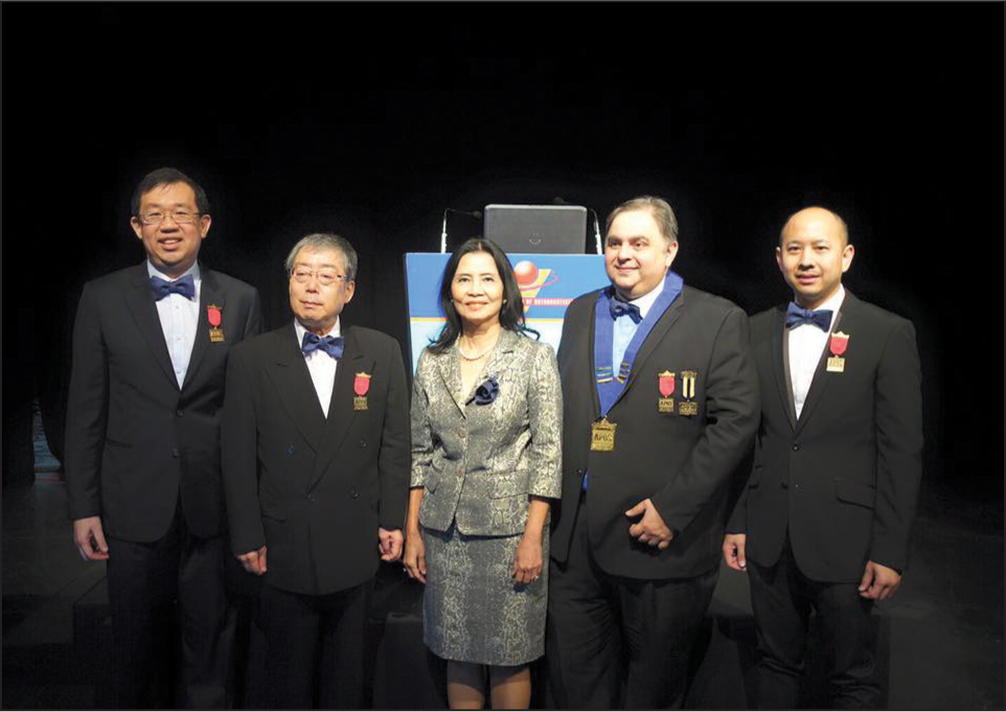
- APOS World Village Day speakers with the Chairs: L-R Dr. Bryce Lee, Dr. Kazuo Tanne, Dr. Somchai Satravaha, Dr. Nikhilesh Vaid and Dr. Tanan Jaruprakorn
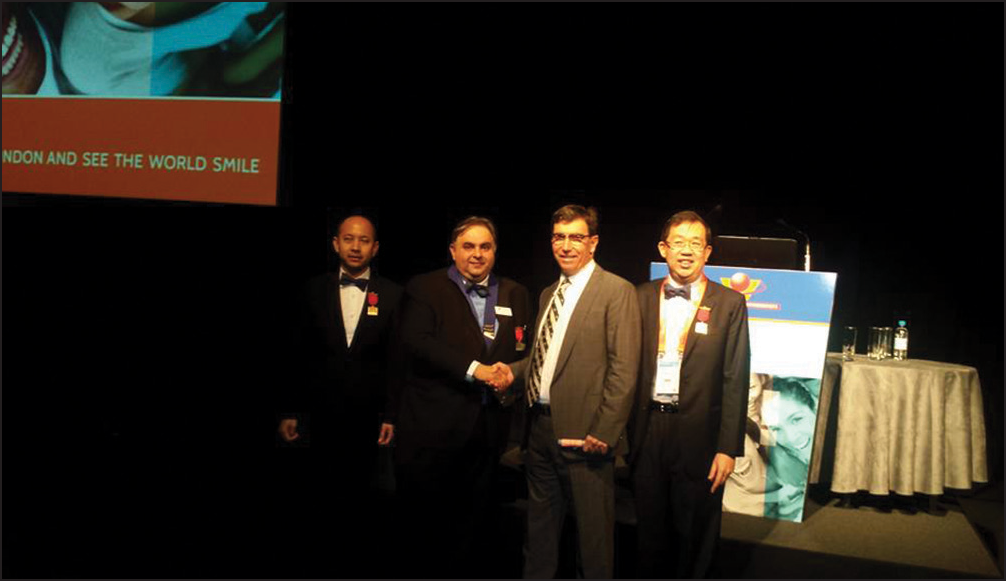
- APOS World Village Day speaker Dr. Mike Razza receives his certificate from the Chairs
The speakers who enthralled the audience on a variety of topics were Dr. Kazuo Tanne (Japanese Orthodontic Society), Dr. Nikhilesh R. Vaid (Indian Orthodontic Society), Dr. Eric Liou (Taiwan Association of Orthodontists), Dr. Somchai Satravaha (Thai Association of Orthodontists), Dr. Mike Razza (Australian Society Singapore Orthodontists) and Dr. Tianmin Xu (Chinese Orthodontic Society).
Dr. Tanne started the proceedings with an overview and statistical data on the status of orthodontics and orthodontic education in the Asian Pacific region with detailed and tabulated research on ground realities in every area that has a constituent association in the APOS. This talk was appreciated and will appear as an article in the APOS Trends soon. I spoke on a research validation and clinical application of Camara’s 6 Horizontal Smile Lines as an Esthetic Check list for finishing, while Dr. Liou literally regenerated the science with a new path breaking concept of Injecting platelet-rich plasma to improve bone volume and quality, in subjects undergoing orthodontics. Both lectures evoked keen audience interest. Dr. Somchai heralded an interesting lecture on limits of compromise in adult patients, and posed interesting questions on whether treatment objectives for adults and growing patients should be the same by showcasing excellent clinical results. Dr. Razza’s insight into autotransplantation, and data backed by excellent outcomes was very encouraging. Dr. Mah’s presentation on impacted second molars was literally a clinical guide on what works, and what does not! Dr. Tainmin Xus’ Physiologic Anchorage control strategy was very innovative and yet simplistic. This concept features in this issue as a special article.
APOS COCKTAIL RECEPTION AT THE INTERNATIONAL ORTHODONTIC CONFERENCE, LONDON
The biggest names in the Global Orthodontic firmament descended at the Fox’s bar at 3:30 pm on September 29, 2015 to celebrate the success of the APOS WVD at the conference. This reception was an initiative by the APOS office bearers to provide a forum to forge new friendships amongst APOS associations (and their leaders), and renew old ones. Attendees smiled, hugged, posed for “selfies,” promised to meet each other soon, thanked the WFO for putting up the conference in the manner that they did, and bonded… yes, very much in “one voice”… the voice of “orthodontics!” [Figures 3-7].

- Dr. Nikhilesh Vaid, President APOS welcomes guests to the Cocktail reception. In the pic: Dr. Joseph Bouserhal, Dr. Eric Liou and Dr. Tom Ahman

- The Cocktail reception: L-R, Dr. Micheal Mah, Dr. Benny S, Dr. Andi Gatot, Dr. Bryce Lee, Dr. Prashant Zaveri, Dr. Eric Liou and Dr. Tanan J
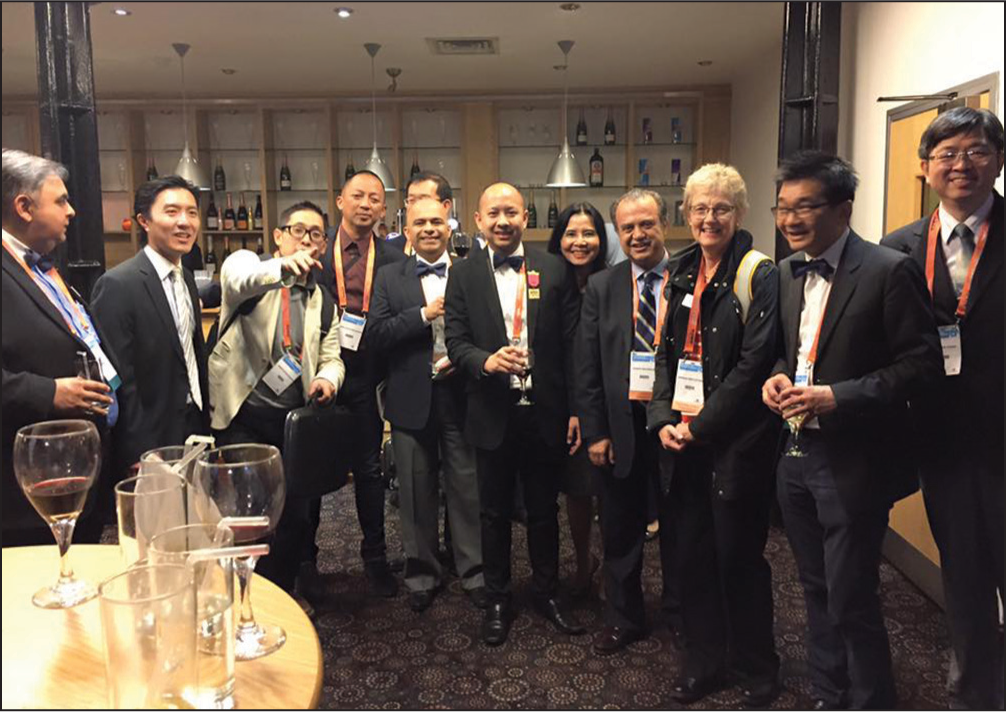
- The Cocktail reception: L-R, the friendship and fun times!
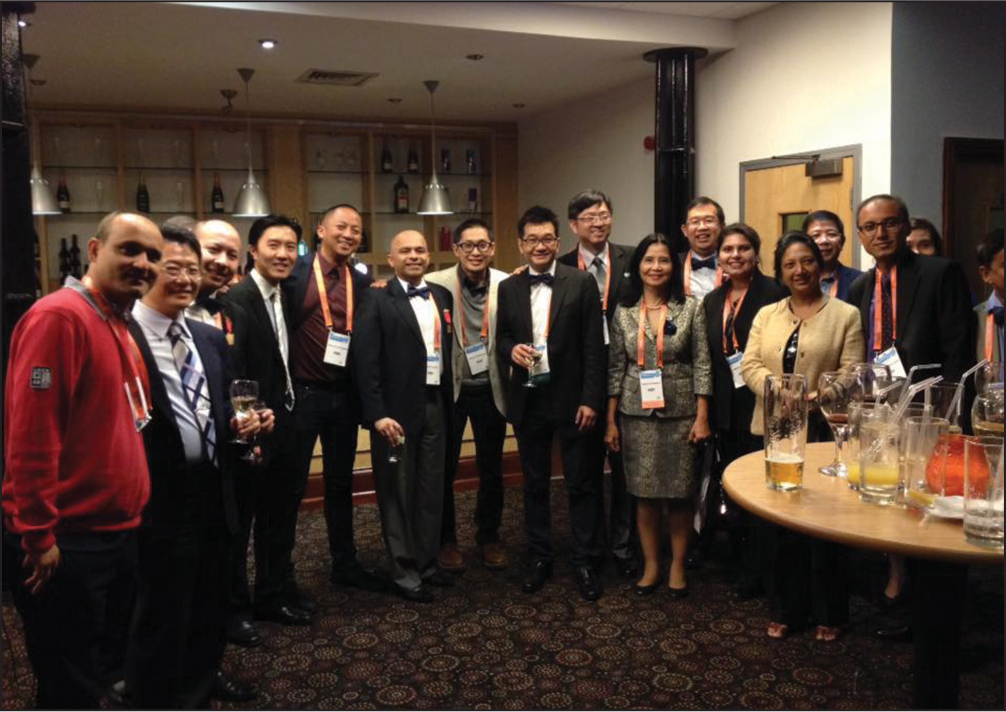
- The camaraderie get together!
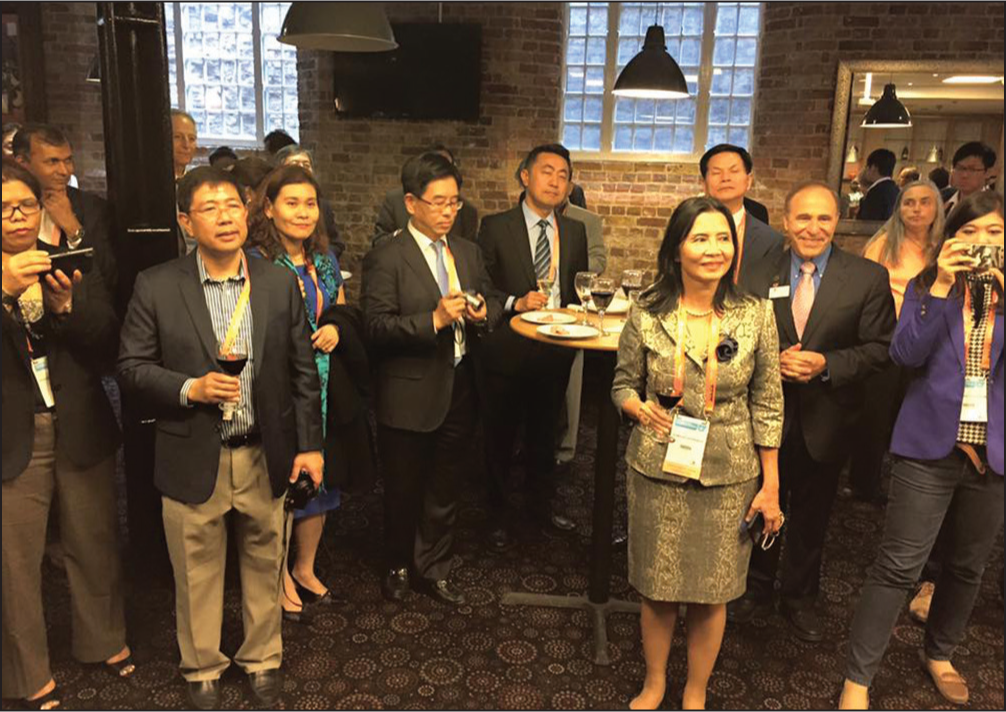
- The esteemed guests at the reception

Nikhilesh R. Vaid1,2,3
1President and Editor in Chief, Asian Pacific, Orthodontic Society, 2Department of Orthodontics, YMT Dental College and Hospital, 3Private Practice, Only Orthodontics, Mumbai, Maharashtra, India
Address for correspondence: Prof. Nikhilesh R. Vaid, Ground Floor, New Blue Gardenia Hsg Society, Peddar Road, Mumbai 26, India. E-mail: orthonik@gmail.com
References
- “Sustaining Human Progress: Reducing Vulnerabilities and Building Resilience”. HDRO (Human Development Report Office) United Nations Development Programme; 2014. Available from: https://en.wikipedia.org/wiki/Human_Development_Report. [Last retrieved on 2014 Jul 25]
- List of Countries by Human Development Index. Available from: https://en.wikipedia.org/wiki/List_of_countries_by_Human_Development_Index. [Last retrieved on 2015 Oct 12]
- [Google Scholar]





